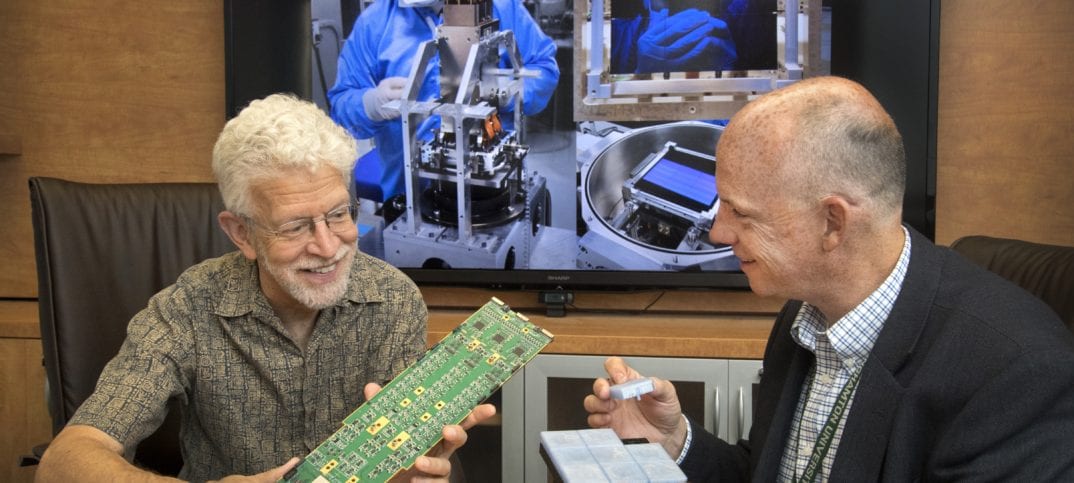By Daniel Dunaief
What’s out there? It’s a question that occurs to everyone from parents sleeping at night who hear a noise in the front yard to tourists aboard a whale watching cruise off the coast of Montauk to anyone looking up at the night sky.
Scientists at Brookhaven National Laboratory recently took a milestone step in a long journey to understanding objects and forces deep in space when they completed shipment of the last of 21 rafts that will become a part of the Large Synoptic Survey Telescope, or LSST, in the Cerro Pachón ridge in north central Chile.
The rafts will serve as the film in a camera that will take images that cover 40 times the area of the moon in a single exposure.
The telescope, which will be the world’s largest digital camera for astronomy, will allow researchers and the general public to view asteroids at great distances. It will also provide information about dark energy and dark matter, changes in the night sky over the course of a decade of collecting data, and data that can build on knowledge about the formation and structure of the Milky Way.
Paul O’Connor, a senior scientist at BNL’s Instrumentation Division who has worked on the LSST for 17 years, expressed appreciation for the efforts of people ranging from area high schoolers to senior scientists on the project.
“It was just a joy to see the dedication from everyone to get what needed to be done,” he said in an email. “It takes a team like that to complete a project like this.”
The LSST, which is funded in part by the National Science Foundation and the Department of Energy, involves researchers from institutions all over the world who have each played a role in moving the unique telescope toward completion.
While the rafts that will function as the film for the 3.2-gigapixel sensor array are completed, O’Connor will continue to work on commissioning the telescope, which should occur gradually until it begins providing data in October of 2022.
O’Connor said the construction of the 21 raft modules containing a total of 200 16-megapixel sensors involved “moments of drama, both good and bad.”
The first time the team brought the system into its operating temperature range of about 100 degrees below zero Celsius, some of the cool-down behavior “differed from our predictions,” he explained.
That required quick thinking to make sure the equipment wasn’t damaged. This was especially important not only because the operation needed to stay on schedule but also because the rafts are expensive and the team was operating on a budget. “Each of these rafts has an enormous cash value” and involved considerable labor to build, O’Connor added.
Bill Wahl, the science raft subsystem manager of the LSST project since 2015, described how one of the challenges involved packing and shipping such sensitive electronic materials.
“We came up with a very elegant and somewhat low-cost approach,” he said, which involved shipping these rafts in a pressurized vessel that avoided damage during any shocks in transit.
The rafts, which each weighs about 25 pounds, had a shipping weight that included protective fixtures of over 100 pounds.
Additionally, the BNL team had to deal with cleanliness, as particulates can and did cause problems. Some of the rafts didn’t function the way they should have after shipping. The BNL team went through a complete refurbishing over six months, where they took all the rafts apart and cleaned them. They upgraded the design to limit the amount of particulates, Wahl said.
While BNL built the requisite rafts, it has an additional two rafts that can replace any of those in the telescope if necessary.
These extra rafts will be stored at the observatory.
Along with the challenges and some anxiety from building such sensitive equipment, the instrumentation unit also had several high points.
In January of 2017, BNL tested one of the rafts in the clean room. Scientists constructed an image projector and projected that onto the raft with enough detail to show that every pixel was functioning correctly. O’Connor made a printout of that image and taped it to his office door.
The day of the successful test was one that the team had been anticipating for “over 10 years. When the first image was delivered, it was very gratifying to see the system was working,” he said.
While O’Connor isn’t a cosmologist, he is particularly interested in the search for dark energy. “It has been puzzling the theorists and as experimentalists, we hope to take measurements that will one day lead to a resolution of this fundamental question,” he explained.
Several teams are working on the LSST in different locations. One of them is constructing the telescope in Chile, while another is assembling the camera in California.
At this point, technicians have installed about half the rafts into the main camera cryostat. Researchers will conduct a preliminary test before populating the rest of the focal plane with all the rafts later this year, O’Connor explained.
As the LSST catalogues four billion galaxies, it will “literally be impossible” to look at these areas item by item. Informatics tools will be necessary to extract all the information, O’Connor said.
Wahl suggested that the LSST could become an important educational tool for budding astronomers.
“I’m not an astronomer or physicist,” said Wahl, who will become the chief operating officer of an instrumentation group at BNL on Oct. 1, “but from my point of view, what I find absolutely amazing is that everyone relies heavily on Google Earth to look at where they are going. In a similar way, [people] are going to do that in the sky. It’s going to give them the opportunity to be junior astronomers unlike they’ve ever been able to do.”
Indeed, the LSST will help people figure out what’s out there.







